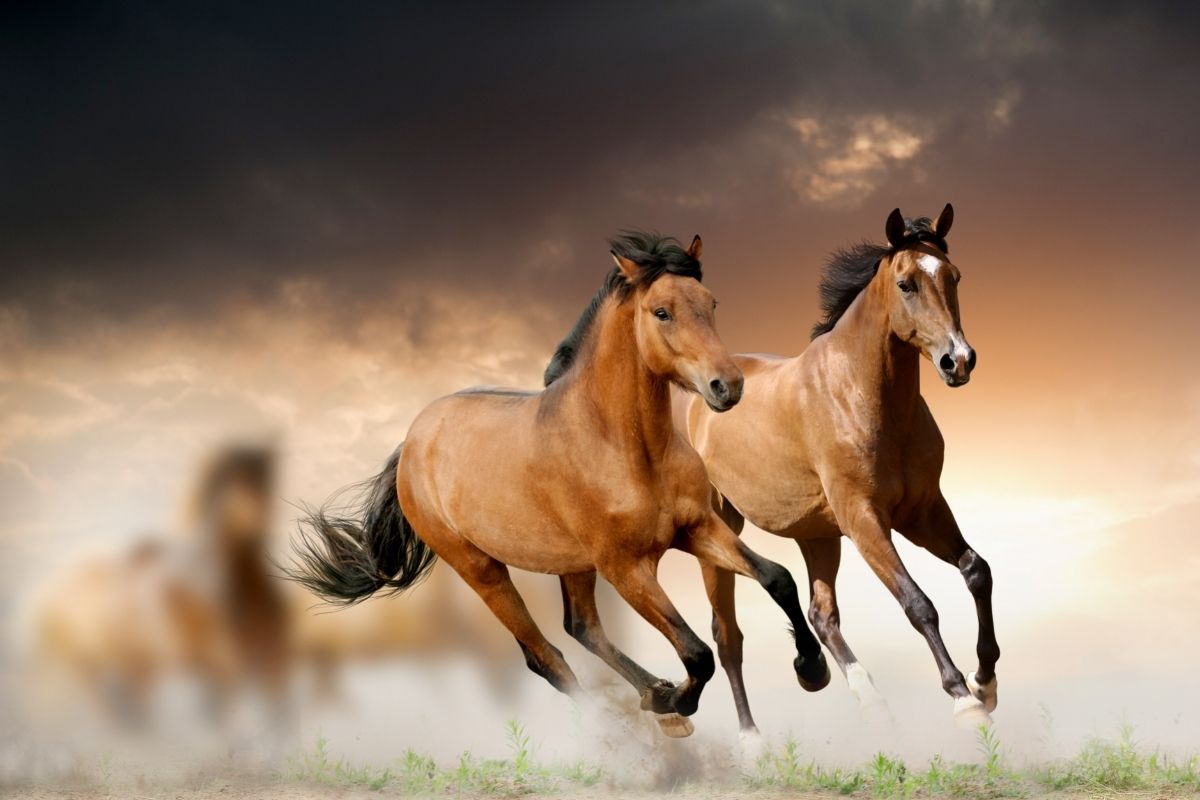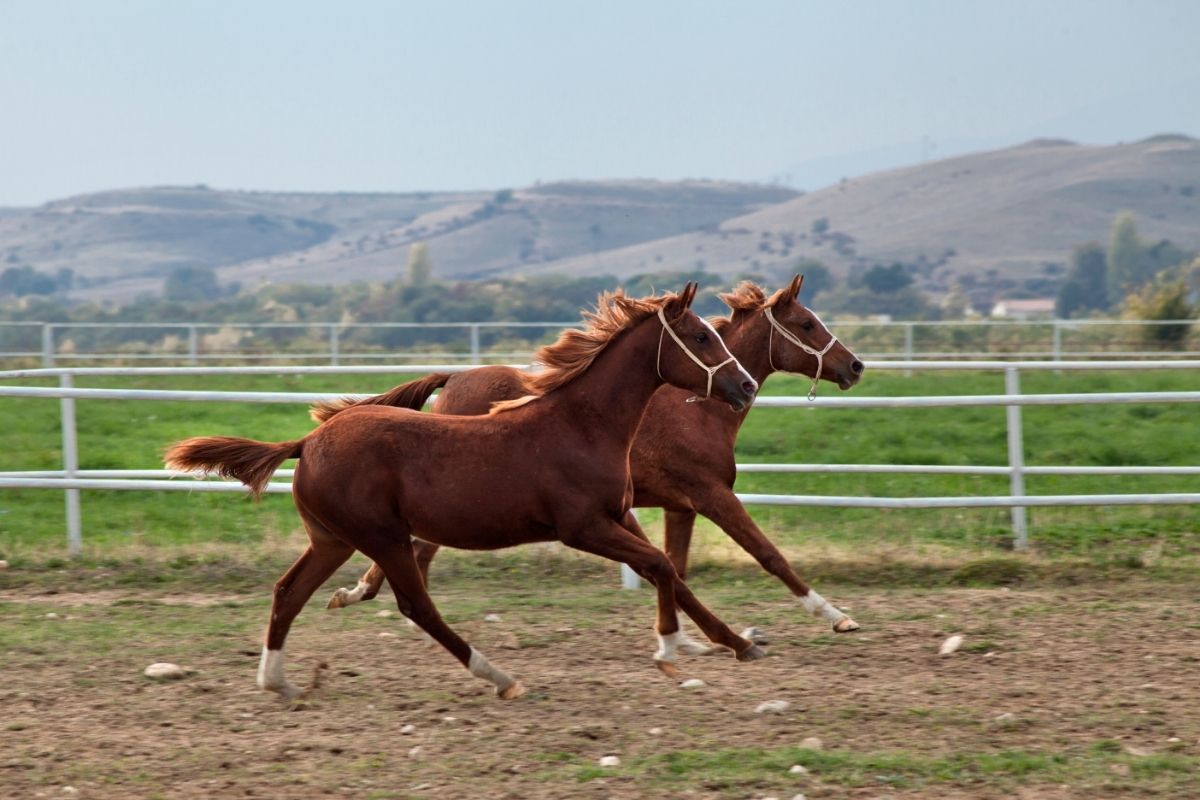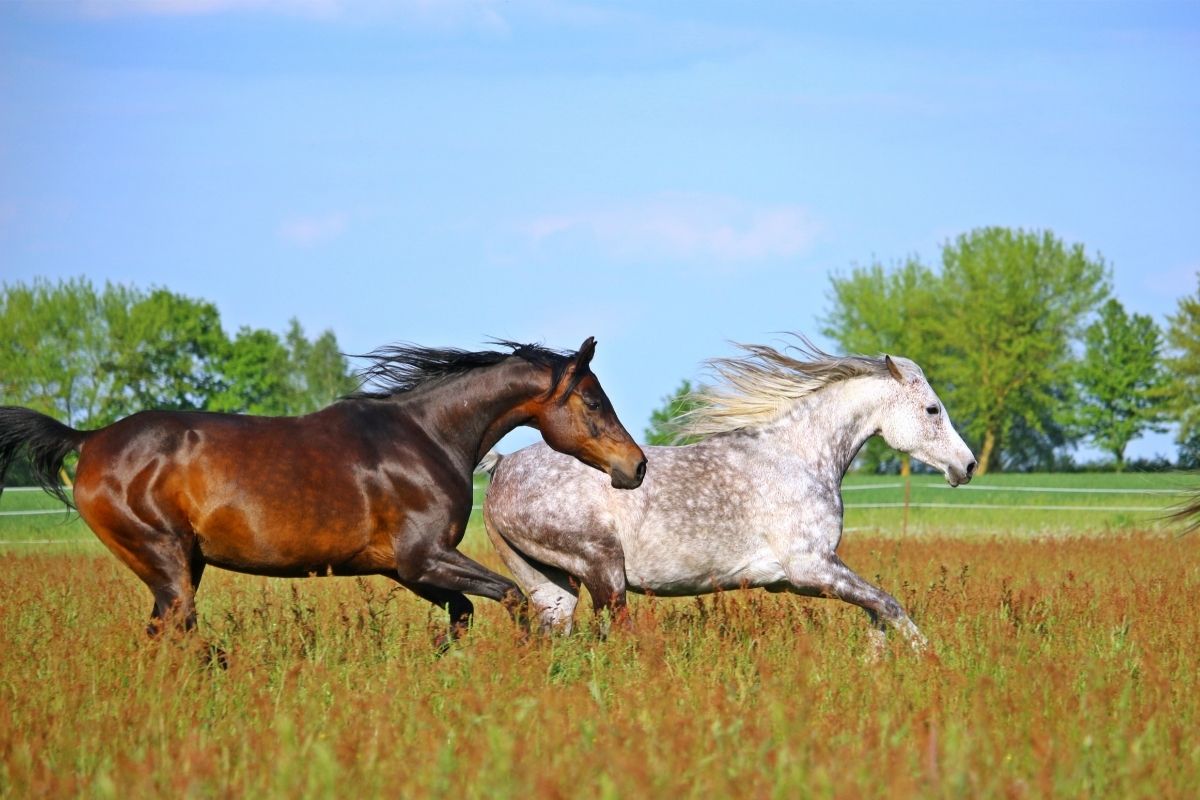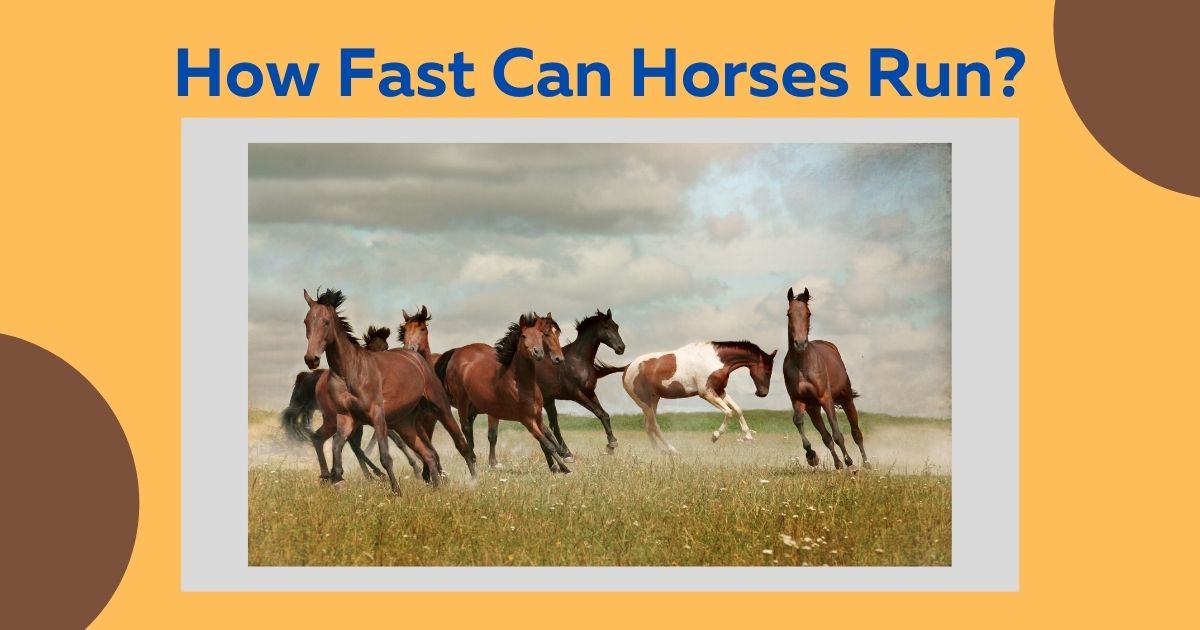Do you know how fast can horses run?
When it comes to animal speed, few can beat a horse. Horses have been domesticated for thousands of years and have been used as a mode of transportation ever since the invention of wheels.
It is said that horses can run at speeds up to 44 miles (70.8 kilometers) per hour, but this is not their top speed. To determine the maximum speed of a horse, you must first know how they move and what factors play into the speed.
To get you started, we have provided facts about how fast can racehorses run and how they move. You’ll also find a list of the fastest horse breeds and how you can make your horse run faster.
Without further ado, here is how fast can a horse run!

The Fastest Horse Speed Ever Recorded
The fastest horse speed ever recorded was 43.97 miles (70.76 kilometers) per hour. It happened in 2008 at the Penn National Race Course, Grantville, Pennsylvania, United States of America. The horse that set the record was Winning Brew.
In 2008, Winning Brew set the current world record for how fast a horse can run when it reached 43.97 miles (70.76 kilometers) per hour in a 437.45 yards (400 meters) race. The horse was able to cover the distance in only 20.57 seconds.
Winning Brew set this world record at the age of two years old. It was a thoroughbred horse trained by Francis Vitale.
How Fast Can Horses Run?
The horse’s average speed is approximately 40 to 44 miles (64.4 to 70.8 kilometers) per hour. However, the typical racehorses’ maximum sustainable speed is around 20 to 30 miles (32 to 48.5 kilometers) per hour for less than 20 seconds and up to 24 miles (38 kilometers) per hour sustained over a distance.
This is slightly faster than the average human can run at top speed for a petite, light horse!
A horse can sustain a fast speed for 20 to 30 yards (18.3 to 27.4 meters) before losing energy. Like humans, horses need time to build momentum before dashing.
It is important to remember that speed is not an indicator of how healthy the horse is. A racehorse must be in peak fitness and health before working at its top speed.
The highest galloping horse speed is 55 miles (88.5 kilometers) per hour. Horses can achieve this efficient gait within a distance of 437.45 yards (400 meters) or less. This sprinting speed can only be achieved by the American Quarter Horses and the Appaloosa.
American Quarter horses and Appaloosas can reach speeds of 55 miles (88.5 kilometers) per hour with a rider on their back, but they cannot sustain this speed for long distances. Before slowing down, the average rate is around 40 to 50 miles (64.37 to 80.47 kilometers) per hour in less than 15 seconds.
Though not the fastest horse, Eclipse was the most successful thoroughbred ever. It was an undefeated racehorse that lived between 1764 and 1789. Eclipse could win any race he entered and won 18 races in a year at his peak.
This horse represents the height of excellence for its breed and can be called the greatest racehorse ever.
Speed of a Horse and How They Move
To understand a speed horse, you must first understand how a horse moves. Horses have a gait that they naturally move into when traveling a long distance. The gait is broken up into four:
- Trot
- Canter
- Gallop
- Walk
Each is distinct and allows the horse to maintain a faster speed for longer periods. The table below shows how fast a horse can move at each of these gaits:
| Gait | Average Speed |
| Trot | 8 miles (12.9 kilometers) per hour |
| Canter | 10 to 17 miles (16 to 27.3 kilometers) per hour |
| Gallop | 25 to 30 miles (40.2 to 48.3 kilometers) per hour |
| Walk | 4.3 miles (6.9 kilometers) per hour |
Trot
The trot is a natural horse gait that gets faster as the horse matures. The trot is a two-beat rhythm faster than a walk but slower than a canter. The trot is the best gait for covering long distances with relative comfort and speed. An average horse can trot 11 yards (10 meters) per second.
Canter (Lope)
The canter is a natural gait horses use to pick up speed and maintain it over a long distance. The canter comprises three beats, making it faster than the walk or trot but slower than the gallop. An average horse can canter 11 meters (10 meters) per second.
Gallop
The gallop is the fastest gait a horse can use to maintain its speed. The gallop comprises four beats, making it the quickest gait that horses naturally use for sprinting over short distances. The acceleration of a horse moving into this gait pattern makes it look like they are floating over the ground.
Walk
This gait pattern is the slowest that a horse can move. A walk comprises four beats, but each takes twice as long as the other gaits. The horse moves both its legs on the same side of its body at once for this gait to keep up its speed while walking. The average horse can walk 2.2 yards (2 meters) per second.

Famous Horse Breeds and Their Top Speeds
Now that you understand race horse speed, let’s look at some of the fastest breeds. The speeds listed below are for horses galloping over short distances, not for sustained speeds over long distances.
| Horse Breed | Horse Average Speed |
| Akhal-Teke | 35 to 45 miles (56.3 to 72.4 kilometers) per hour |
| American miniature horse | 18 to 20 miles (29 to 32.2 kilometers) per hour |
| American Quarter | 45 to 55 miles (72.4 to 88.5 kilometers) per hour |
| Andalusians | 45 to 50 miles (72.5 to 80.5 kilometers) per hour |
| Appaloosa | 30 to 40 miles (48.5 to 64.5 kilometers) per hour |
| Arabian | 34 to 40 miles (55 to 64.5 kilometers) per hour |
| Belgian Horse | 25 miles (40.2 kilometers) per hour |
| Black Forest | 14 miles (22.5 kilometers) per hour |
| Clydesdale Horse | 20 miles (32 kilometers) per hour |
| Friesian Horse | 25 to 30 miles (40 to 48.5 kilometers) per hour |
| Gypsy Horse | 22 miles (35.5 kilometers) per hour |
| Morgan Horse | 20 miles (32 kilometers) per hour |
| Mustang | 35 to 50 miles (56.5 to 80.5 kilometers) per hour |
| Orlov Trotter | 45 miles (72.5 kilometers) per hour |
| Paint Horse | 40 miles (64.5 kilometers) per hour |
| Selle Francais | 15 miles (24 kilometers) per hour |
| Shire Horse | 30 to 35 miles (48.5 to 56.5 kilometers) per hour |
| Standardbred | 30 to 35 miles (48.5 to 56.5 kilometers) per hour |
| Tennessee Walking Horse | 10 to 20 miles (16 to 32 kilometers) per hour |
| Thoroughbred | 35 to 44 miles (56.5 to 71 kilometers) per hour |
| Wild Horse | 30 to 40 miles (48.5 to 64.5 kilometers) per hour |
Factors That Determine Equine Speed
So, how fast can a horse run with a rider on its back? The answer to this question depends upon several factors.
Weight of the Horse
The weight of a horse is one of the most important factors that determine its speed. The heavier a horse is, the greater energy they need to move their weight forward. This means that it requires more effort for a heavy horse to run at the same rate as a light horse.
Anatomy of Horse
Horses, like other animals, have proportional and highly functional muscles, as well as robust bones. They have both slow-twitch and fast-twitch muscle fibers, just like any other animal.
Slow-twitch muscle fibers are best suited to endurance activities like walking and trotting, while fast-twitch fibers give them the speed and explosive power needed for galloping.
Different breeds have various muscle fiber compositions, making them suited for distinct tasks.
For example, draft horses have a more significant proportion of slow-twitch fibers, making them better suited for pulling loads with steady progress. On the other hand, racehorses have a more considerable proportion of fast-twitch fibers, making them fit for sprinting at high speeds.
Horse Gender
While the sex of a horse is not an essential factor in determining its speed, breeding practices adapted to the different genders will affect how fast is a racehorse.
The speed difference between female and male horses under four years old is 1% (females tend to be slightly faster than males).
Breed of Horse
The breed of a horse is an essential factor in determining how fast it can run. Horses were selectively bred over time to produce horses with different physical attributes.
Some breeds are better suited for endurance activities like pulling heavy loads for long periods, while others are more suitable for speed and sprinting in short bursts.
Over 100 recognized breeds globally, each with distinct physical attributes that define how fast they can run.
Terrain of Horse
The terrain over which a horse travels also affects racehorse speed. Horses can naturally walk and trot over virtually any kind of terrain. However, the landscape over which they gallop is limited to smooth or rough surfaces. Horses can’t run at their speediest gait over an uneven or slippery surface.
The terrain’s surface also influences how much weight a horse can carry when moving at certain speeds. For example, horses protected with horseshoes can sustain the force of impact with rough surfaces better than those not protected.
The surface also determines how much friction the horse has to deal with, which can affect how fast is a racehorse. For example, mud slows the movement of a horse down, making them sprint at a much slower speed than they can on grass or dry ground.
Stride Frequency of Horse
The stride frequency of a horse is how many strides it takes to complete one cycle. It’s determined by the length of their legs and the speed of a horse. Strides are measured in meters, and any horse can complete around 130-140 strides in one minute when galloping at its top speed. Other horses complete about 160 strides per minute.
Stride frequency is essential when measuring how fast a racehorse is. It can be used to determine how much ground they cover in the same unit of time. This can be used to compare their relative speeds.
Training of Horse
The training that a horse receives affects the speed of a horse. Racehorses are conditioned to gallop for long periods at high speeds. This requires them to be trained from a young age to build up their strength and stamina and teach them how to breathe correctly when sprinting.
Horses that are not trained for race activities will move much slower than those trained to gallop at high speeds for long periods.
Weather of Horse
The weather can affect the horse’s average speed. Hot weather makes it difficult for the horses to cool down, affecting their capacity to run at top speeds.
This is why races are traditionally held in the spring and autumn when the temperature is most temperate. Excessive rainfall also slows down horse speed as they must wade through standing water when running.
Wind also affects how fast a racehorse is. Horses are sensitive to changes in the weather, particularly wind. For example, a slight shift in direction will alter their running speed so they can get closer to the side of the wind rather than run headlong into it.
How Can You Make a Horse Run Faster?
It is important to remember that horses are animals, not machines. You can’t make them run faster by applying speed-enhancing drugs or performance-boosting technology.
That said, several factors affect horse speed, and they can all be controlled by humans with varying degrees of success. Here are some of the ways you can make a horse run faster.
Frequent Training
It is not possible to make a horse run faster without proper training. You must condition your horse from an early age to build its strength and stamina.
This includes teaching them how to gallop at high speeds for long periods without getting tired and determining the right pace for specific distances and terrains.
Roadwork and sprinting can also help develop a horse’s top speed, while exercises like trotting, galloping, zig-zagging, and weaving help improve the horse’s capacity for speed. Never skip out on training sessions as they are essential to determining how fast can horses run mph.
Good Diet
Racehorses need a special diet to sustain their high level of activity. They should be fed at least three times a day with a high carbohydrate and protein-based diet. This can include oats, hay, alfalfa, and other similar foods.
Supplements are also helpful for providing the horse with the necessary proteins and nutrients to perform optimally.
A malnourished horse will not be able to gallop fast or for long periods. This can affect how fast they can run over various distances.
Good Breeding
A horse’s genetics determines the speed of a horse. Horses bred for racing can be closely related to winners, which means they have the genes necessary to be fast.
This means that thoroughbreds, quarter horses, and other breeds are better suited for racing than other equines. A thoroughbred racehorse is more likely to have the genes that make them fast than a standard breed, for example.

Summary
So how fast can horses run mph?
The average galloping speed of a horse is approximately 30 miles (40.28 kilometers) per hour. It is possible to increase their top speed through training and proper diet, but how fast a horse can run mainly depends on how well they are bred.
If you want to know how fast are horses overall, remember that thoroughbreds are more rapid than standard horses. However, the thoroughbreds’ speed is determined by their genes.
Please visit our website for more articles related to how fast is a racehorse.
